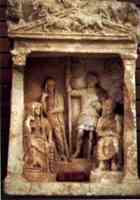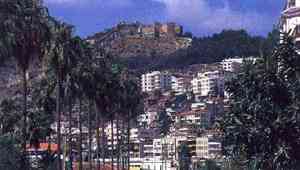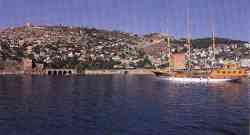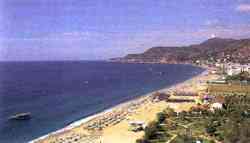

ALANYA-CORACESIUM
Alanya, which has one of the most remarkable views on Turkey's south coast,
lies on a rocky peninsula jutting into the sea. It possesses interesting houses, sheer precipices, and fortification walls.
The first known settlement founded on the site of present day Alanya was
Coracesium, meaning rock. This city was sometimes included in the province of
Cilicia, sometimes in Pamphylia. Strabo, proceeding west to east in his
description of Cilicia, starts with Coracesium, describing it as a castle set on
a steep cliff.
sea. It possesses interesting houses, sheer precipices, and fortification walls.
The first known settlement founded on the site of present day Alanya was
Coracesium, meaning rock. This city was sometimes included in the province of
Cilicia, sometimes in Pamphylia. Strabo, proceeding west to east in his
description of Cilicia, starts with Coracesium, describing it as a castle set on
a steep cliff.
Due to its ideal harbour and eminently defensible situation, this site served in almost every period as a pirate's or rebel's den. For this reason it was the only Cilician city to resist Antiochos III in 199 B.C. A half century later, Diodotos Trypon, the local ruler, also refused to remain allied with Antiochos VII. Piracy in the Mediterranean in the first century B.C. was a great economic and political problem for the Roman Empire; the seizure of grain ships by pirates reached such proportions that it threatened even Rome with widespreaad hunger. For this reason, Puplius Servius was sent to Cilicia in 78 B.C., and organized a series of campaigns against the pirates, but the was ultimately unsuccessful. Next he was empowered by the Roman Senate in 65 B.C., and he subdued all of the pirate strongholds by attacking them both by land and by sea. Coracesium, was the last to fall, and in the process not only was the pirate fleet destroyed, but the city's fortification walls were pulled down and the stones pitched into the sea.
During the Roman imperial era, Coracesium must have become a large city, for in the second century it began for the first time to mint coinage in its own name.
Not much is known about Coracesium in the first centuries of Christendom and the early Byzantine period. Together with its neighbours Cilicia and Pamphylia, it must have accepted Christianity at an early date.
 This
period, too, witnessed a change in the name of the site; it became known as
Kalonoros or Beautiful Mountain. This name continued to be employed in various
permutations well into the Middle Ages. Even after its conquest by the Turks,
the city was known by the Venetians, Genoese, and Cypriots under the rubric
Candelor, Scandelore, or Galenorum.
This
period, too, witnessed a change in the name of the site; it became known as
Kalonoros or Beautiful Mountain. This name continued to be employed in various
permutations well into the Middle Ages. Even after its conquest by the Turks,
the city was known by the Venetians, Genoese, and Cypriots under the rubric
Candelor, Scandelore, or Galenorum.
As soon as the Rum Seljuk sultan Alaeddin Keykubad I (reigned 1220-1237) ascended the throne, his first strategic ploy was to move against this castle. On securing its surrender from its ruler Kyr Vard, he affixed his own name to the town, calling it Alaiye. İts proximity to the Seljuk capital of Konya as well as Alaeddin's harbour improvements, assured the town's rapid development. Because the sultan wintered in Alanya, the town witnessed much construction activity, and was provided with the wonderful buildings we see today.
After the collapse of the Seljuk state, this area passed into the control of the Karaminids and was sometimes administered by local rulers swearing allegiance to them. Often the Lusignan kings of Cyprus tried to lay hands on Alanya, and the Turks and the Egyptians used it as a base from which to invade Cyprus. With the rise of the Ottoman Empire, commerce in the eastern Mediterranean declined, and Alanya lost most of its former importance. Today, Alanya is one of the best preserved of all Seljuk cities.
The eastern section of the Alanya castle borders the sea and is protected at the site of its conjunction with the northern wall, by a large octagonal tower known as Kızıl Kule, or the Red Tower. This tower is 29 metres in diameter and 33 metres high. Despite its simple exterior, the tower's interior consists of a series of defensive systems combined with a complex five-storey plan. The two lower storeys of the upper portion is built of reddish bricks, giving rise to the tower's name. Inscriptions record that this tower was built for Alaeddin Keykubad in 1226 by the architect Abu Ali of Aleppo. The tower was restored between the years 1951 and 1957.
Some 150 metres to the south of the Red Tower, lies the sole surviving Seljuk tersane or naval yard. The total area of 57x40 metres is divided by walls into five vaulted spaces. Each one of these is connected to the others by four doorways with pointed arches; these interior spaces were large enough to serve as construction areas for medieval ships. The tersane is entered from the direction of the Red Tower. The entrance carries a five-line inscription attributing the construction of the naval yard to Alaeddin Keykubad in the year 1227. The first line reads, "Victory for God and early conquest" (Koran LXI, 13). A small room to to the right of the entrance may have been used as a storeroom, or perhaps a mosque for workmen in the naval yard, although there is no mihrab niche present to indicate the direction of Mecca. A room to the left is lit by daylight and was probaly used as an office.
To the south of the naval yard rises a two-storey tower (called today the Tophane) designed to protect it from landward or seaward attack. This square tower; 19 metres in height, was erected on a high cliff. The ground floor is divided into four vaulted rooms by interior walls. The upper floor takes the form of an open room surrounded by vaulted bays.
The north walls, starting from the Red Tower, stretch up to a fortified area
known as the Ehmedek. Built on the ruins of earlier Hellenistic fortifications,
two structures, each possessing three towers, form a highly irregular plan. The
principal entrance is from a large gate to the east. From here one climbs stairs
to a small tower. Immediately inside the entrance lies a large amorphous open
area with cisterns. Further on are three large rooms. Scratched in the plaster
near a window of the eastern room are representations of pre-contemporary
sailing boats. The middle room probably served as a residence hall, and the
small domed room in north-west corner was its bath. The north face of the base
tower of the Ehmedek contains a beautiful inscription dating to 1227, during the
reign of Alaeddin Keykubad.
earlier Hellenistic fortifications,
two structures, each possessing three towers, form a highly irregular plan. The
principal entrance is from a large gate to the east. From here one climbs stairs
to a small tower. Immediately inside the entrance lies a large amorphous open
area with cisterns. Further on are three large rooms. Scratched in the plaster
near a window of the eastern room are representations of pre-contemporary
sailing boats. The middle room probably served as a residence hall, and the
small domed room in north-west corner was its bath. The north face of the base
tower of the Ehmedek contains a beautiful inscription dating to 1227, during the
reign of Alaeddin Keykubad.
If one goes due south from the Ehmedek, one encounters the Süleymaniye mosque. This mosque is divided into two main areas; a square main chamber surmounted by a dome, and in front of it, a porch with three domes separated by arches. The domes are made of brick, and the walls of ashlar masonry as well as brick. At the north-west corner of the mosque rises a duodecagonal minaret.
South from the mosque is a caravanserai consisting of a wide courtyard surrounded by rooms for travellers and merchants. The wide vaulted section behind the rooms was used for animals.
The Akşebe Türbe or tomb lies above the caravanserai. The principal building was a single-domed until build of reddish brick. Adjacent to the domet space and along its eastern face lie another similar domed area and a vaulted room. A small minaret decorated with blue tiles rises to the north-east of the door to the structure.
The citadel lies at the highest point of the castle and is in the form of an irregular rectange 180x150 metres. The original buildings of this area were built against three sides of the surrounding fortification wall. The western side required a less substantial wall because of its proximity to a sheer drop. Two big cisterns built of brick lie in the middle of this space. If one takes into account the castle's historical importance, a place should have existed in this area, but so far no such building has been found among the ruins evident in the citadel. If it did exist, however, it was most probably situated in the south-east corner, since this area contains much collapsed building debris and traces of painted frescoes. A Byzantine church can also be seen here in the citadel, undisturbed by the construction around it. The church has a cross-shaped plan, surmounted at the crossing by a high dome on pendentives. A few remains of frescoed figures are still to be seen in the side apses and on the pendentives.
A small chapel built on the southern fortification wall bears witness to the three principal phases of occupation at Alanya. This structure, known today as Arap Evliyasi (Arab Saint), was built during the Byzantine period on top of the ruins of a Hellenistic tower. In Seljuk times the church was incorporated into the defensive wall, with a crenelated parapet carefully built above it. The church, entered from the east, is surmounted by a low dome made of brick, and can be dated on stylistic grounds to the eleventh century A.D. This structure was subsequently used as a mosque.
This gigantic county , soon become a city itself , is the most important touristic center of the Mediterranean region.
It will be preferable to take Alanya in two parts as Eski (the Old) and Yeni (the New) Alanya.
Eski Alanya was founded on the top and sides of the high peninsula dividing the county into two. As for the castle overviewing the town on both sides, it is probably the most attractive spot. The castle walls going up for 6,5 km to the Inner Castle on the hill was initially built during the Hellenistic period but raised further, fortified and furnished with 110 towers during the Seljukid period.
As for Yeni Alanya , it extends towards both the east and west of the peninsula. The beac beginning in Antalya direction and interrupted for a while by the peninsula extends further for many kilometers in Gazipaşa direction. This strech constitutes the main zone of construction in Alanya.
Tremendously increased particularly during the last decade, hotels, pensions and private residences are lined side by side on the main road parallel to the beach and connected with transverse streets and avenues to the main road.
The Historical Town Center
It would be most becoming to start the tour in the historical town center of Alanya from the harbor.Starting a tour from Kızıl Kule (the Red Tower), you can make your way towards the Shipyard, the middle part of the castle and the inner castle on the top.
Kızıl Kule (Red Tower)-The Shipyard
 Regarded as the
most attractive architectural structure of Alanya and almost a symbol of
the town , Kyzyl Kule was commissioned by Alaeddin Keykubat , the
Seljukid Sultan in 1226, and called Kızıl Kule for the red
(Turkish : kızıl) bricks used in the construction. Kızıl
Kule is 33 m. High having an octagonal plan with five storeys.
Regarded as the
most attractive architectural structure of Alanya and almost a symbol of
the town , Kyzyl Kule was commissioned by Alaeddin Keykubat , the
Seljukid Sultan in 1226, and called Kızıl Kule for the red
(Turkish : kızıl) bricks used in the construction. Kızıl
Kule is 33 m. High having an octagonal plan with five storeys.
The bottom floor
of the tower, where one pays an entrance fee, is used as an annex of
Alanya Museum for exhibition of ethnographic works of art. You can see
costumes of the Ottoman period, hand-woven textiles of the region and
looms where these handicrafts were produced among the works of art
exhibited. leaving the tower behind,
follow the pathway by the walls for a further 200 m after going down the stairs;
you will reach the shipyard, again built during Sultan Keykubat’s period. The shipyard was built two years after the tower and is the only remaining shipyard
from the Seljuks. It has five docks each of 7 m. Widht and 43 m. Depth all
opening to the sea.
shipyard was built two years after the tower and is the only remaining shipyard
from the Seljuks. It has five docks each of 7 m. Widht and 43 m. Depth all
opening to the sea.
Alanya Castle
After Kızıl Kule and the Shipyard, Alanya Castle follows as part of the tour.It takes 45 minute walk to climb up the castle.
Don’t miss to see Arap
Evliyası which was built as a church in the 11th century
and then converted into a mosque; the Süleymaniye Mosque, the Bedesten
(market place) beside the mosque, resored and now used as a
restaurant,bar and hotel, Ehmendek where the commander of the castle  resided, little houses of Alanya remaining from the Seljuks and the
Ottomans, Akşebe Sultan Masjid and Tomb. You can then go up the Inner Castle.
Entrance to the Inner Castle is charged. The entrance gate opens to the large
courtyard where on the left side you will see the big cistern vaulted with red
bricks on the top. This cistern is the biggest of 400 cisterns existing on
various parts of the castle and is still in use. One of the most important works
of art present in the inner castle is the Byzantine Church (Aya Yorgi), once
used as a Masjid during the Seljuks’s period, standing in quite strong and
good condition.
resided, little houses of Alanya remaining from the Seljuks and the
Ottomans, Akşebe Sultan Masjid and Tomb. You can then go up the Inner Castle.
Entrance to the Inner Castle is charged. The entrance gate opens to the large
courtyard where on the left side you will see the big cistern vaulted with red
bricks on the top. This cistern is the biggest of 400 cisterns existing on
various parts of the castle and is still in use. One of the most important works
of art present in the inner castle is the Byzantine Church (Aya Yorgi), once
used as a Masjid during the Seljuks’s period, standing in quite strong and
good condition.
Adam Atacağı Tower
is the last spot of the inner castle tour. It is related that the
prisoners of the Roman times were made to play a similar gamble. They
were given three stones and one who managed to throw the stone into the
sea was released whereas those who could not were thrown into the sea
through a catapult. The name Adam Atacağı (=Man Thrower) is
given for that reason.
were made to play a similar gamble. They
were given three stones and one who managed to throw the stone into the
sea was released whereas those who could not were thrown into the sea
through a catapult. The name Adam Atacağı (=Man Thrower) is
given for that reason.
Damlataş Cave
After the Castle tour , the second route climbing down leads you to the entrance door of Damlata? Cave which lies to the west of the peninsula. The Damlataş beach is also named after this cave.Adorned with alluring
stalactites and stalagmites of various colours, the cave has a constant
temperature of 22-23 degrees Celsius. It is said that the atmosphere of
the cave has a healing effect on asthma except the allergic type  and
rheumatism with a humidity of 90-100 % and very high rate of carbon
containing some radioactivity.
and
rheumatism with a humidity of 90-100 % and very high rate of carbon
containing some radioactivity.
The section where stalactites and stalagmites are seen is a cavity of 13-14 m. Width and 15 m. Height. Tours to the cave are scheduled in two different types: Sight seeing as well as health tours.
Caves
Join one of the excursions to cover the Alanya Peninsula from the sea, and to see Kızıl Kule, Tersane and Alanya Castle. During this excursion, your vessel will call at three caves. The first stop is the Pirate’s Cave. The second is the Aşıklar Mağarası (cave) and the third one is Fosforlu Mağara (cave). Vessels are able to enter the caves. Once inside, the water shines almost as if phosphorescently . Hence , the name : "Fosforlu Mağara". Swimming here is an enjoying experience.
Alanya Museum
Alanya is a rich historic site. The museums of the town gives a clear idea of the wealth. Alanya Museum comprises of three secions. The first is employed to display archaeological finds belonging to the Hellenistic, Roman and Byzantine periods. There are finds dated to prehistory, too. The bronze statue of Heracles in this section is remarkably impressive. There are ethnographic objects in the second section. Majority of the works are manuscripts, Korans and calligraphy. Also inside the museum a sample Alanya Home can be seen. The pieces displayed in the courtyard, comprise the third section. Sarchophagi and similar archaeological objects are displayed here.
![]()
Home | Ana
Sayfa | All About Turkey | Turkiye
hakkindaki Hersey | Turkish Road Map
| Historical Places in Adiyaman | Historical
Places in Turkey | Mt.Nemrut | Slide
Shows | Related Links | Guest
Book | Disclaimer | Send a Postcard | Travelers' Stories | Donate a little to help | Getting Around Istanbul | Adiyaman Forum
|
|